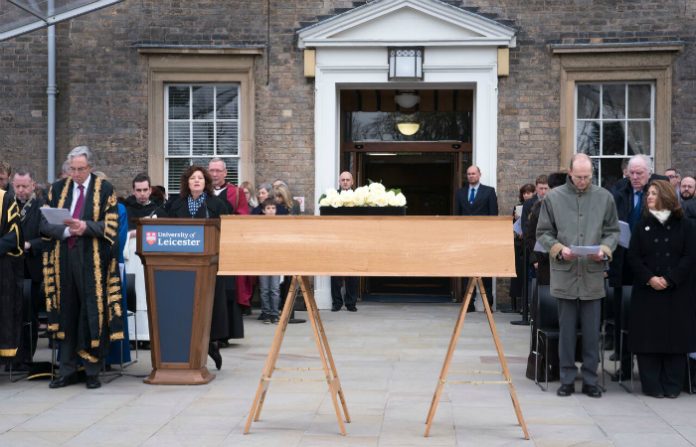Universities dream of the blockbusting discovery that will print their name in the history books. In 2013, that day arrived for the University of Leicester when it discovered and identified the remains of the mythical Richard III. Ather Mirza reflects on how the spine-tingling discovery was revealed to the world through a sophisticated plan of media engagement.
“The discovery of Richard III’s body underneath the Leicester car park was one of the most successful UK university media operations ever”. That was the view from The Guardian in 2015, following up from praise they had heaped on the University of Leicester in 2013 describing the announcement of the discovery of mortal remains as “The most extraordinary press conference ever held at any UK university.”
All very flattering – but how did we do it? The University of Leicester used the unprecedented occasion of the reinterment of Richard III to demonstrate the importance of their research and to mark his legacy with honour and dignity.
We created a sense of theatre around the launch of the dig-with medieval knights, ground penetrating radar and a range of experts for media to interview.
There is no magic formula to the media management of a find like this but one thing that was absolutely crucial was the teamwork (bolstered by a sense of collective pride and responsibility) around this project. From its surprising start to its dignified conclusion, this unique project drew on the skills of academic, professional, administrative, clerical and manual staff. No monarch had been buried in this country since 1952.
No medieval English monarch had ever been buried in modern times. The eyes of the world were watching.
Five key elements of success
Success in the co-delivery of this momentous project relied on:
- Inspirational leadership
- World-class academic excellence
- Teamwork within the university and with external partners
- Journalistic ‘nous’
- Comprehensive film and photography
The media success of the Richard III project reflects the application of journalistic knowledge and techniques in a university setting. We ensured:
1. We did not set ourselves up for failure from the outset because we focused on the importance of making archaeological discoveries – and not simply on finding Richard III
2. We created a sense of theatre around the launch of the dig-with medieval knights, ground penetrating radar and a range of experts for media to interview.
3. We applied the principle that less is more when the dig began and provided a daily drip feed of archaeological progress and discoveries of artefacts- with no mention of human remains.
4. We organised a press conference at the end of the dig to reveal discovery of mortal remains- but then announced the research had entered a new phase. We had moved from an archaeological dig to a scientific search.
5. We recognised there would be a media void during the scientific research period – so we filled the void with other stories relating to Richard.
6. We created a news blackout in the weeks leading to the final announcement and signed NDAs with key media organisations to access our images and film
7. The announcement: we organised the most complex press event – described as a cerebral X-factor by one journalist – where academic experts disclosed their scientific findings leading to the conclusion from lead archaeologist Richard Buckley that we had, beyond reasonable doubt, discovered the mortal remains of King Richard III.
8. Working with our partners at Leicester Cathedral and Leicester City Council, the University of Leicester then successfully planned, organised and delivered the largest, most complex and most important royal event outside of London since the investiture of HRH The Prince of Wales in 1969. The people of Leicester, thousands of visitors from the UK and across the globe, and millions of people watching live on television, witnessed the culmination of a truly remarkable story.
“It spoke to different people across the world”
This project is exceptional for a number of reasons. It deployed multidisciplinary research activity in an unprecedented way. Geneticists, osteologists, archaeologists, weapon experts, engineers, latinists, forensic pathologists, historians and genealogists all played key roles in the project. The journal Nature noted: “The University of Leicester has managed to unite the two cultures of science and humanities in a way that few have before”.
Further, it used cutting edge scientific technique in novel ways – particularly the use of ancient DNA. It is the first time that DNA and genealogy have been used to conclusively identify a skeleton of this age.
It spoke to different people across the world for different reasons including academic, heritage and archaeological communities, staff and students, Parliament which debated the significance of the find. Above all it spoke to the public who thronged to the site, pored over our website, watched our videos and followed the events via the media and social media.
The archaeological dig cost £45,000 with the University of Leicester the largest single contributor. The scientific search thereafter was funded entirely by the University of Leicester. A multi-million pound visitor attraction now stands at the site of the dig and the mortal remains of King Richard III have been re-interred in Leicester cathedral just yards from where he was discovered.
The discovery of King Richard III brought in more than £59m to Leicester’s economy, from the time of the discovery to the reinterment, according to an independent assessment. It’s estimated that around £4.5m of this was generated during the two weeks of reinterment activities. The value of media coverage obtained throughout the project was £16.5m (Advertising Value Equivalent), with one billion people around the globe given the opportunity to see coverage of the discovery and reinterment.
Read more about the discovery here








